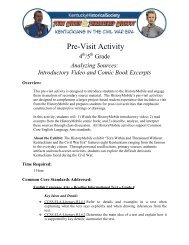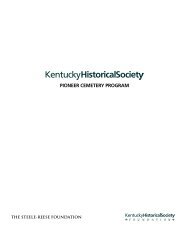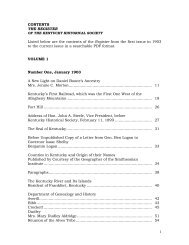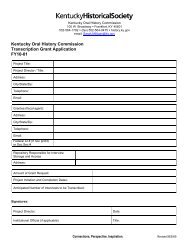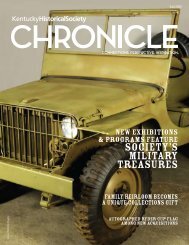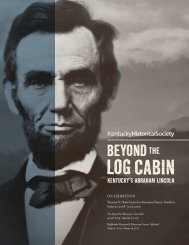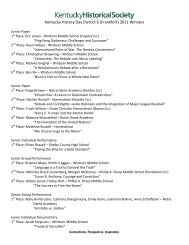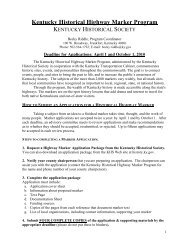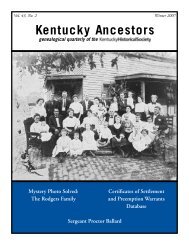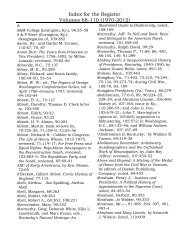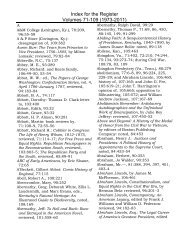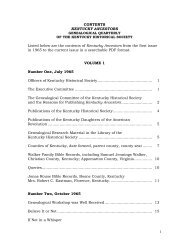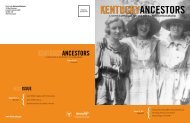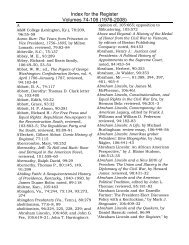Packet--Middle School - Kentucky Historical Society
Packet--Middle School - Kentucky Historical Society
Packet--Middle School - Kentucky Historical Society
Create successful ePaper yourself
Turn your PDF publications into a flip-book with our unique Google optimized e-Paper software.
EXHIBITION EDUCATOR PACKET<br />
KENTUCKY<br />
MILITARY<br />
TREASURES<br />
SELECTIONS FROM THE<br />
KENTUCKY HISTORICAL<br />
SOCIETY COLLECTIONS<br />
www.history.ky.gov/military<br />
Carved Bone “Texas Die,” ca. 1848,<br />
Donated by Russell M. Hughes, 1983.02.02
KENTUCKY<br />
MILITARY<br />
TREASURES<br />
A SOLDIER’S ESSENTIALS<br />
OBJECT OBSERVATION AND ANALYSIS<br />
EXHIBITION OVERVIEW<br />
“<strong>Kentucky</strong> Military Treasures: Selections from the <strong>Kentucky</strong> <strong>Historical</strong> <strong>Society</strong> Collections”<br />
highlights personal stories that exemplify the military experience and demonstrate the<br />
significant contributions and sacrifices that Kentuckians have made in service to the nation<br />
in battle and at home. This selection of artifacts is pulled from the collection of the <strong>Kentucky</strong><br />
Military History Museum which is housed at the Old State Arsenal.<br />
“<strong>Kentucky</strong> Military Treasures” is thoughtfully presented in a timeline chronicling major<br />
U.S. conflicts beginning with the War of 1812 and continuing to present engagements in<br />
Afghanistan and Iraq. Within the exhibition students can examine primary sources including<br />
artifacts, photographs and manuscripts from over 200 years of military history. They will<br />
also have the opportunity to study signature stories highlighting the experiences of seven<br />
Kentuckians and their service in the military. Also included in the exhibition are a selection of<br />
personal experiences told through letters, poems, audio recordings, oral histories and emails.<br />
BACKGROUND INFORMATION<br />
SELECTIONS FROM THE<br />
KENTUCKY HISTORICAL<br />
SOCIETY COLLECTIONS<br />
CONTENT RECOMMENDED FOR ELEMENTARY/MIDDLE SCHOOL STUDENTS<br />
War of 1812<br />
Often called the Second War of Independence, the War of 1812 once again pitted the U.S.<br />
against Great Britain. Impressment of seamen and infringement of commercial rights<br />
prompted President James Madison’s call for war. Also, the U.S. objected to British alliances<br />
with Native Americans that frustrated its expansion westward. <strong>Kentucky</strong> contributed<br />
approximately 18,000 troops to the war and suffered a high proportion of the nation’s<br />
casualties. The war ended in a negotiated settlement in 1814. Prominent <strong>Kentucky</strong> statesman<br />
Henry Clay, already Speaker of the House, played an important part in this effort.<br />
Mexican-American War<br />
In 1845, the annexation of Texas strained diplomatic relations between the U.S. and Mexico.<br />
When diplomacy failed, war broke out in 1846. Drawing on a strong military tradition,<br />
Kentuckians from all walks of life volunteered. Approximately 5,000 volunteers from the<br />
commonwealth served in four regiments during the two-year war. The war focused national<br />
debate on the extension of slavery into the southwest, in the name of Manifest Destiny. Internal<br />
strife over the expansion of slavery led the nation toward the Civil War.<br />
Civil War<br />
In 1861, following many years of debate and futile attempts at compromise over the issue<br />
of slavery, sectional tension finally erupted in civil war. A month after the outbreak of war,<br />
<strong>Kentucky</strong> chose a policy of neutrality. Four months later, <strong>Kentucky</strong> abandoned its neutral<br />
stance to support the Union, but this hardly resolved the problem of divided loyalties within the<br />
commonwealth. Kentuckians served in both the Confederate and Union armies. Over 24,000<br />
<strong>Kentucky</strong> African Americans wore Union blue. During the Civil War, more American soldiers died<br />
from battle wounds and disease than in any other conflict. Technological advances changed<br />
the nature of warfare, making it deadlier than ever before.<br />
World War I<br />
Fragile alliances holding Europe together collapsed in 1914. The international war drew in the<br />
U.S. within three years. Some 84,000 Kentuckians, 13,000 of them African Americans, served in<br />
the war and about 2,400 died. The contributions of men and women left behind led to the first<br />
widespread use of the term “homefront.” Deadlocked in trench warfare, the conflict caused<br />
death and destruction on a scale as never seen before. The war brought down empires, created<br />
a new and unstable world order and entangled the U.S. irreversibly in world military affairs.<br />
ARTIFACT LIST<br />
War of 1812<br />
1.<br />
Powder Horn, ca. 1830 (1987.79.01)<br />
Mexican-American War<br />
2. Silver-trimmed<br />
Mexican Saddle, 1848 (1941.1) [rotating]<br />
3. Texas Die, ca. 1843 (1983.02.02)<br />
4. Soldier’s “Housewife,” ca. 1846 (1983.02.01) [museum exhibition only]<br />
Civil War<br />
5.<br />
SECTIONS<br />
OBJECTIVES<br />
CORE CONTENT<br />
CONNECTIONS<br />
A.C. Dickens Civil War Diary, 1861 (98SC287) [online exhibition only]<br />
War of 1812, Civil War,<br />
Mexican-American War,<br />
World War I<br />
To learn about the items<br />
caried by soldiers.<br />
SS-EP-5.1.1, SS-04-5.1.1,<br />
SS-06-5.1.1
A SOLDIER’S ESSENTIALS<br />
OBJECT OBSERVATION AND ANALYSIS<br />
(CONTINUED)<br />
World War I<br />
6. Gas<br />
Mask and Bag, ca. 1918 (1976.100.03)<br />
7. G.A. Morgan’s Gas Mask Patent Drawing, 1914<br />
VOCABULARY<br />
We encourage you to introduce the following vocabulary words independently or in conjunction<br />
with the pre-visit activities.<br />
Artifact something created by humans usually for a practical purpose<br />
Battlefront the military sector in which actual combat takes place<br />
Homefront the location of civilian activity during war<br />
Powder horn a flask for carrying gunpowder<br />
Whittle to pare or cut off chips from the surface of wood with a knife<br />
ACTIVITY*<br />
Artifact Analysis<br />
Divide objects up amongst students and have them record observations and analysis by<br />
answering the following questions.<br />
Object-Observation Questions<br />
1. What color(s) is the object?<br />
2. What do you think it feels like?<br />
3. List any designs or patterns you see on the object.<br />
4. What material(s) do you think it is made of?<br />
Analysis Questions<br />
1. What do you think the object is?<br />
2. How do you think the object could have been used?<br />
3. Who might have used it?<br />
4. Where might it have been used? (In the field, in camp, etc.)<br />
5. Does it remind you of anything?<br />
Interpretation Question<br />
1. What does this artifact tell us about the life and times of the people who made it and<br />
used it?<br />
*All artifacts and information for this activity can be found on the online exhibition.



